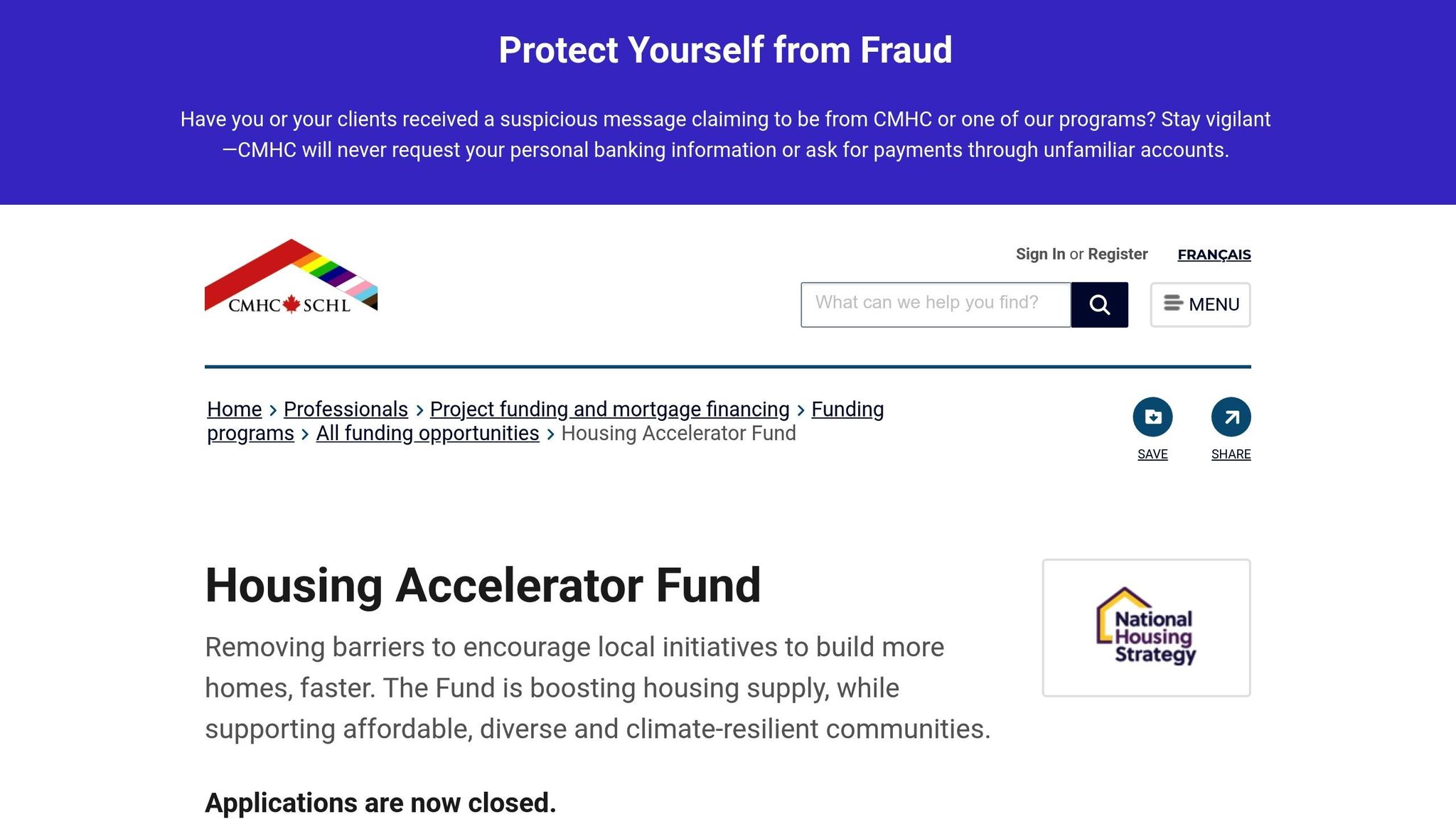Halifax is tackling its housing shortage with a $79.3 million federal Housing Accelerator Fund (HAF) designed to speed up multi-unit rental development. A key feature? ER-3 upzoning, which replaces restrictive single-family zoning to allow up to eight units on a single property. This change aims to create 2,600 new housing units by 2026, contributing to Halifax’s goal of 15,467 units by 2027. Property owners can now take advantage of streamlined approvals, reduced costs, and new financing options to build medium-density housing near transit corridors. However, understanding ER-3 zoning rules, municipal requirements, and funding eligibility is essential to maximize opportunities.
Halifax Wants URGENT CHANGES to Planning Rules for Housing
ER-3 Upzoning Rules and Benefits for Property Owners
Halifax's ER-3 zoning marks a major change in residential development rules, aiming to address the city’s housing challenges. Effective June 13, 2024, this zoning replaces the restrictive ER-1 single-family zoning that previously limited housing options across much of Halifax’s urban core[4]. For property owners, understanding these new regulations is key to taking advantage of the housing shortage and new funding opportunities.
ER-3 Upzoning: What’s New?
The ER-3 zoning overhaul allows for multi-unit developments, a significant departure from the ER-1 restrictions that only permitted single-family homes. Under ER-3, property owners can now build up to eight units on a single lot[3].
Key features of ER-3 include:
- Building Height: Structures can now reach up to 12 metres (three storeys), exceeding the 11-metre limit under ER-2 zoning.
- Lot Size Flexibility: Lots of 600 m² or more can support townhouses or apartment buildings with up to eight units and 20 bedrooms[3][5].
- Strategic Locations: ER-3 zones are placed near Halifax Transit Corridor Routes (Routes #1-10) or planned Rapid Transit routes, ensuring easy access to public transportation and essential services[4].
- Neighbourhood Compatibility: Design rules aim to preserve the character of existing neighbourhoods by limiting building depth and width[4].
- Mixed-Use Potential: Ground-floor commercial spaces and medical clinics are allowed, adding value and creating additional income opportunities for property owners[7].
"You cannot build affordable housing if you were not allowed to build affordable housing. The previous zoning was too restrictive to build any kind of housing." - Joseph Kirby, co-founder of More Homes Halifax[5]
These changes open up new possibilities for small and mid-sized property owners to contribute to Halifax’s housing solutions.
New Opportunities for Property Owners
The shift from ER-1 to ER-3 zoning is a game-changer for property owners who were previously limited to single-family developments. The new framework supports missing middle housing - medium-density buildings that fill the gap between single-family homes and high-rises[3].
Here’s what ER-3 zoning means for property owners:
- Increased Income Potential: Properties that once housed a single family can now accommodate multiple units, generating rental income. For example, a four-unit building could bring in $7,800 to $8,400 per month, with an annual return on investment (ROI) of 12–20%.
- Flexibility for Development: ER-3 zoning permits up to eight townhouses in a row, allowing owners to adapt their projects to the size and layout of their lot[7].
- Streamlined Construction: Traditional building methods often involve juggling multiple professionals, leading to delays and budget overruns. An integrated construction model simplifies the process with fixed-price contracts - around $160,000 per unit - and a six-month timeline, making projects more predictable and manageable.
Halifax’s housing shortage is pressing, with a deficit of nearly 18,000 units and a projected need for 52,000 units by 2027[3]. ER-3 zoning is designed to help meet this demand while offering property owners significant financial incentives.
Financial Support and Faster Approvals
The ER-3 framework also makes it easier for property owners to access financing and complete projects faster. For instance:
- CMHC MLI Select Financing: Offers 95% financing with a 5% down payment and a 50-year amortisation period. While energy-efficient buildings may cost around $200,000 per unit, these favourable terms improve cash flow and affordability.
- Government Funding: Halifax is receiving $79 million over three years to support housing development. This funding is streamlining approval processes, cutting timelines from 12–18 months to much shorter periods. Faster approvals mean lower carrying costs and quicker project completion.
With these changes, property owners are better positioned to navigate the development process, secure funding, and maximise their returns in Halifax’s evolving housing market.
How to Access the Housing Accelerator Fund: Step-by-Step Process

Halifax's $79.3 million Housing Accelerator Fund (HAF) offers property owners a way to address the housing shortage while supporting the creation of 2,600 new housing units. This initiative, managed by Halifax Regional Municipality (HRM) in partnership with Canada Mortgage and Housing Corporation (CMHC), is part of a larger goal to develop 15,467 new units by 2026 [1].
Eligibility Requirements and Application Steps
The HAF aims to simplify development by reducing approval times and cutting through red tape. To ensure your project aligns with the fund’s objectives, consider the following criteria:
- ER-3 Zoning Compliance: Your project must comply with the existing ER-3 zoning requirements.
- Multi-Unit Housing: The fund prioritizes developments with four or more rental units, as these significantly add to Halifax's housing supply.
- Transit Accessibility: ER-3 zones are typically located along major transit routes [6], which aligns with the HAF's focus on accessible housing.
For questions about your specific project, reach out to Halifax's Housing Accelerator Fund team at haf@halifax.ca [1].
Once your project meets these criteria, you’ll need to address the municipal requirements outlined below.
Meeting Municipal Requirements
After confirming eligibility, ensure your project adheres to municipal standards under the HAF framework. These include:
- Lot Requirements: Properties must meet minimum standards, such as a lot size of 325 m² and 10.7 m of frontage for 1–4 unit dwellings. Typical lot coverage is around 40%, though some areas may allow between 35% and 50% [6].
- Affordable Housing Pilot Program: This initiative is limited to non-profit and charitable organizations. Private property owners can participate by partnering with a non-profit, but the land title and management of affordable units must remain with the non-profit partner [8].
Municipalities can provide additional guidance to help streamline the approval process. Coordinating early with planning, design, and construction teams can lead to more accurate permit applications and avoid delays caused by miscommunication or incomplete submissions.
Timeline and Support Resources
Once you’ve secured municipal approval, review the project timeline and available resources to keep things on track. The HAF program runs through 2026, with funding distributed annually [1][9].
Timelines will vary by project, so it’s a good idea to consult municipal planning documents like the Centre Plan and Land Use By-law for detailed ER-3 zoning regulations [6]. Working with professionals familiar with HAF and ER-3 requirements can also make the process smoother.
For additional assistance, Halifax’s planning department and the Housing Accelerator Fund team are available to guide you through the application process.
Maximizing Density and Construction Profits Under ER-3 Zoning
With new funding sources and updated zoning regulations, property owners in Halifax have a golden opportunity to boost the value of their developments. ER-3 zoning, in particular, opens the door for profitable multi-unit projects, addressing Halifax's pressing housing shortage of nearly 18,000 units. By carefully planning and optimizing density, property owners can meet this demand while achieving solid financial returns [3].
Strategies for Maximizing Density
The increased flexibility under ER-3 zoning makes strategic planning essential for those looking to maximize rental income and property value.
- Build vertically while adhering to setbacks and coverage limits. This approach lets you increase the number of units without exceeding zoning restrictions.
- Design efficient floor plans. For example, well-thought-out 2-bedroom layouts can command rents ranging from $1,950 to $2,100, offering returns of 12–20%.
- Focus on energy efficiency. Features like triple-pane windows and ductless heat pumps not only lower operating costs but also make properties eligible for favourable financing, such as CMHC MLI Select. This program offers up to 95% financing with only a 5% down payment for projects exceeding standard efficiency codes.
A real-world example from Halifax highlights the financial potential of density optimization. A modest 1940s home on Dudley Street, valued at $250,000, was replaced with three townhomes, each valued between $500,000 and $600,000 [14]. This transformation underscores how strategic densification can significantly boost property value.
"It is a transformational opportunity to drive housing in our community."
– Jacqueline Hamilton, Halifax's executive director of planning and development [3]
Integrated vs. Fragmented Construction Approaches
While maximizing density is essential, the construction method you choose can make or break a project's profitability. Traditional fragmented construction - where design, engineering, and building are handled through separate contracts - often leads to coordination headaches, delays, and unexpected costs.
Design-build integration offers a smarter alternative. By working with a single, unified team, property owners can streamline the entire process. Research shows that design-build projects are completed 33.5% faster and experience 5.2% less cost growth compared to traditional methods. Additionally, these projects often come with approximately 6% lower unit costs [10].
Integrated construction also reduces risk. Fragmented approaches can lead to disputes among architects, engineers, and contractors, leaving property owners to mediate. In contrast, design-build provides a single point of accountability, simplifying problem resolution and reducing potential conflicts.
Here’s how the two approaches compare:
| Factor | Design-Build | Traditional Construction |
|---|---|---|
| Cost | 6% lower overall costs with fewer change orders [12] | Lower initial bids but higher risks of cost overruns [12] |
| Timeline | 12% faster due to overlapping phases [12] | Longer timelines with sequential phases [12] |
| Owner Involvement | Minimal, with a single point of contact [12] | High, requiring coordination across multiple contracts [12] |
| Risk Management | Centralized accountability reduces disputes [12] | Fragmented responsibility increases risk [12] |
| Project Complexity | Excels in complex projects with integrated teams [12] | Better suited for simpler projects [12] |
For ER-3 developments, budget predictability is critical, as soft costs can account for 8% to 33% of total project expenses [13]. Integrated construction often includes fixed-price contracts, which help avoid the budget overruns - sometimes as high as 30–60% - that can plague fragmented projects. This cost certainty allows for more accurate ROI calculations and smoother financing.
Involving construction professionals early in the design phase is another key to success. Their expertise can guide decisions on cost-effective materials, efficient construction methods, and potential value engineering opportunities [11]. This proactive collaboration helps prevent costly delays and ensures that projects stay on schedule and within budget.
Finally, the adaptability of integrated construction is a major advantage for multi-unit developments. ER-3 projects often require adjustments mid-construction, whether to refine unit layouts or address unforeseen site challenges. The design-build model allows for real-time problem-solving, keeping projects on track and ensuring optimal outcomes [10].
sbb-itb-16b8a48
Meeting Zoning and Regulatory Requirements
Navigating Halifax's ER-3 zoning regulations requires a clear understanding of the rules outlined in the Centre Plan. Being well-versed in these requirements can help you avoid delays and keep your construction timeline on track. Here's how to tackle these regulations effectively.
Key Regulatory Requirements
The Centre Plan is Halifax's effort to modernize and simplify its development process by consolidating various plans into a unified framework [15]. This shift has significant implications for how property owners approach ER-3 developments, particularly regarding permits and compliance.
Understanding ER-3 Zoning is essential. ER-3 zoning allows for the construction of different housing types, each with specific requirements for setbacks, lot coverage, and design standards [6]. Familiarizing yourself with these details is critical for staying compliant.
Development Permits and Timelines: Once a permit is issued, construction must begin within one year to maintain development rights [15]. This makes proactive planning a key factor in meeting deadlines and avoiding setbacks.
As-of-Right Development simplifies the approval process. If your project meets all zoning regulations, you'll only need a development permit - no additional approvals from Halifax Regional Municipality (HRM) Council are required [15]. This can significantly cut down on waiting times and reduce uncertainty.
Transition Requirements come into play for projects near existing residential areas. The municipality mandates setbacks and landscaped buffers when ER-3 developments border other ER zones [15]. These measures aim to balance new construction with the surrounding neighbourhoods.
Avoiding Common Problems
Even with clear guidelines, some issues can still slow down the approval process. Here are a few common challenges and how to address them:
- Neighbourhood Opposition: Concerns about changes to the neighbourhood, such as increased traffic, noise, or impacts on property values, can arise [16]. Engaging with the community early and maintaining open communication can help ease tensions and build support.
- Documentation Errors: Missing or incomplete paperwork is a frequent cause of delays. Carefully review zoning ordinances to ensure all requirements are met and all necessary documents are submitted [16].
- Development Agreement Expiry: If your property has an agreement from before the Centre Plan was adopted, be aware of "sunset clauses." Failing to request extensions before these agreements expire could derail your project [15].
- Non-Conforming Structures: If your property includes structures that no longer align with the updated Land-Use By-law, understand how this might affect your plans for renovations or new builds [15].
Local Support and Resources
Halifax provides several resources to help property owners navigate zoning and regulatory requirements:
- HRM Planning & Development: This department is your go-to for questions about zoning, permits, and compliance. You can reach them at planhrm@halifax.ca [15].
- Regional Centre Land Use By-law (LUB): The LUB offers detailed definitions and illustrations to clarify complex zoning rules [15].
- Public Hearings: Attending public hearings allows you to share your concerns, protect your appeal rights, and better understand community feedback [16].
- Legal and Professional Advice: Consulting a land use lawyer can help you navigate legal requirements. If zoning regulations pose challenges, exploring variances could provide a quicker and less contentious path to approval [16].
Successfully navigating Halifax's zoning regulations involves early engagement with municipal staff, thorough preparation, and clear communication with the community. Using these resources wisely can help ensure your project runs smoothly and aligns with Halifax's housing goals.
Conclusion: Using Halifax's Multi-Unit Housing Opportunities
Halifax’s $79.3 million Housing Accelerator Fund (HAF) presents a rare chance for property owners to both tackle the city’s housing shortage and build profitable rental properties. The mix of federal funding and ER-3 upzoning has created a new landscape for residential development in the city.
The HAF is set to deliver 2,600 net new housing units by 2026, contributing to a broader goal of 15,467 units over three years [1]. A key part of this initiative is the as-of-right approval for four-unit developments, which simplifies what was once a complicated approval process.
ER-3 upzoning has transformed the economics of construction. By increasing lot coverage limits to 60% and eliminating minimum parking requirements, it significantly lowers development costs [17]. This change has opened up areas previously restricted to single-family homes, allowing for higher-density projects across much of the Regional Centre [18].
Regulatory and zoning reforms are just one piece of the puzzle. The streamlined permitting process under the HAF Action Plan further accelerates project timelines. With reduced upfront costs and access to pre-approved building plans, small and mid-sized property owners can now enter the market more easily [1]. Rental income projections of $1,950–2,100 per unit and annual returns of 12–20% make these projects financially appealing.
Traditional construction methods often face challenges like coordination issues, cost overruns of 30–60%, and lengthy delays. However, adopting an integrated design-build approach can help avoid these pitfalls. With fixed pricing around $160,000 per unit and timelines as short as six months, this method offers a more efficient path to completion.
To make the most of these opportunities, property owners should act quickly and strategically. Confirming eligibility under ER-3 zoning, designing plans that maximize the four-unit allowance, and leveraging municipal resources are critical first steps. Additionally, exploring incentives for affordable or transit-oriented housing can enhance both financial returns and community benefits [2].
Halifax’s housing market is at a pivotal moment. Those who take advantage of these initiatives now can create profitable rental properties while playing a key role in addressing the city’s urgent housing needs. By embracing these strategies, property owners can achieve strong returns and contribute meaningfully to Halifax’s housing future.
FAQs
What steps should property owners take to meet ER-3 zoning requirements for multi-unit developments?
Navigating ER-3 Zoning Requirements in Halifax
If you're planning to build in an ER-3 zone, the first step is to determine the maximum number of units permitted on your property. Depending on the specific area, this can range from 3 to 8 units. Once you've got that figured out, make sure your plans align with all zoning rules, including setbacks, lot coverage limits, and height restrictions.
Before breaking ground, don’t forget to obtain the required permits and approvals from the Halifax Regional Municipality. Skipping this step could lead to delays or complications down the line.
By staying on top of these requirements, you can navigate Halifax's zoning regulations smoothly and make the most of the opportunity to develop multi-unit rental properties.
What financial incentives and support does the Halifax Housing Accelerator Fund provide for property owners?
Halifax Housing Accelerator Fund: Encouraging Rental Development
The Halifax Housing Accelerator Fund offers financial incentives to promote the construction of multi-unit rental properties. These incentives include grants and funding designed to support zoning changes, such as permitting up to four units on most residential lots.
By streamlining development processes and providing financial support, the program aims to help property owners add secondary units and increase property density. This initiative is a key part of Halifax's efforts to tackle the housing crisis and boost the availability of rental options.
What are the benefits of using an integrated construction approach for ER-3 zoned developments in Halifax?
An integrated construction approach makes life easier for property owners by putting all responsibilities into the hands of a single, accountable team. This is a big shift from traditional methods, where multiple contracts and disconnected workflows often lead to delays, unexpected costs, and plenty of headaches.
For ER-3 zoned developments in Halifax, this approach is particularly helpful. It simplifies the process of meeting zoning requirements, optimizes density, and allows property owners to tap into profitable opportunities with fewer obstacles. By creating a clear and consistent path, the integrated method ensures projects for multi-unit rental properties are delivered more smoothly and with better results.



